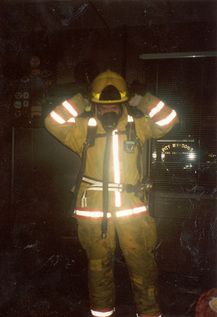Fire Equipment
This photograph features a fireman in full gear with a Pitt Meadows Fire Department truck in the background. The gear that firefighters wear is traditionally called “turnout” gear. Historically the uniform would consist of thick wool pants, and red shirts with rubber slickers overtop their wool uniforms. Wool was chosen as it had the ability to shield against heat and cold and was mildly resistant to water and flames. Following the second World War, the Fire Protection Association (USA) imposed new equipment standards (which Canada also conformed to) that mandated that firefighters uniform have several layers-one flame-resistant, one moisture-resistant, and one that provided insulation. As technology improved so did the material used to create the gear. Gloves and boots that were worn by firefighters were traditionally made of leather, eventually the boots would be replaced by rubber and the gloves would be replaced by fire/heat resistant gloves as well. In the early years of a fire department the uniform varied significantly from location to location, and as we move into a more modern time the uniform starts to become more unified across Fire Departments. Fire helmets are a particularly important part of their gear. The long brim is to protect the user from falling debris and the longer back would protect the user’s neck from flames. Traditionally the colour of the helmet denoted the wearers rank. Chiefs would wear a white helmet, captains and lieutenants wore a white helmet with a red/black back for example. In recent times however this changed to most firefighters wearing yellow hats to allow for greater visibility. Modern helmets also include visors and eye shields and other mechanisms to provide the user more safety and security. Can you imagine how hot it would get in those suits?
Details:
Latitude: 49.2245199953396
Longitude: -122.68761436624
Direct Link: https://www.pittmeadowsmuseum.com/locations/fire-equipment


